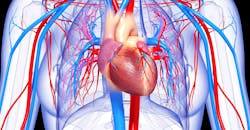Artificial Blood Vessel Made from Natural Polymers Dissolves as New Cells Replace It
Biomedical researchers at Johns Hopkins University have developed a vascular graft (blood vessel) that could help people with coronary artery disease and children born with cardiovascular defects.
Coronary artery disease, or CAD, is the leading cause of death worldwide and people with it often need surgery to repair damaged cardiovascular tissues. Bypass surgery, another common intervention, requires removing the damaged tissue and replacing it with blood vessels from another part of the body, such as the saphenous vein, which runs the length of the leg and is the longest vein in the body. This method puts substantial stress on the body and has other risks as it requires patients to have several surgeries.
Cardiovascular defects occur in 1% of live births worldwide, and children born with them often undergo repeated surgical reconstruction as they grow. But repeated surgeries reduce the amount of usable vascular tissue for reconstruction and synthetic grafts do not grow as the child grows.
Synthetic grafts pose other challenges such as clotting, which blocks blood flow, and grafts grown from stem cells often require up to eight weeks of preparation.
To improve surgical practices and reduce the number of surgeries a person with CAD may need, Hopkins researchers developed a vascular graft that encourages new tissue formation with better mechanical properties that mimic natural arteries. They developed a graft that takes less than a week to prepare instead of eight, dissolves as healthy tissue grows in its place, and can withstand the continuous contraction and relaxation cycle that the beating heart puts on arteries and veins.
“The goal was to combine electrospinning technology and stem cells to create a novel vascular graft that decreases fabrication time significantly, even more than grafts moving through clinical trials, while also decreasing clotting and enhancing tissue regeneration,” says Morgan Elliott, a researcher and doctoral candidate in the Biomedical Engineering Dept.
Electrospinning creates thin fiber threads by applying an electrical charge and mechanical pulling to the fibrin polymer. The team chose fibrin for their graft because it is a natural polymer made by the body that prevents blood clotting, encourages new tissue formation, and increases elastin production. Elastin is a critical protein in arteries that helps tissue retain its shape after stretching. Sheets of fibrin are then rolled in an alternating pattern to create a hollow tube, which is then dehydrated and stored for later use.
Once rehydrated, the graft’s exterior is reinforced with a poly(ε-caprolactone), or PCL, sheath to prevent sutures from tearing the graft. From there, the team follows different preparatory steps before implanting the graft, depending on the patient's needs. For emergency needs, grafts can be implanted immediately after rehydration. For patients with chronic vascular disease that know they will eventually need surgery, their stem cells can be collected and embedded on the graft before implantation.
In a mouse study, the team created small vascular grafts 0.6 mm in diameter and 3 to 5 mm long with and without stem cells and tested them in the abdominal aorta. After six months, both graft types showed no evidence of clotting, new tissue formed from inside the graft outward, and the grafts could maintain mechanical properties similar to healthy blood vessels. The grafts encouraged elastin production, which has typically been a challenge in the field. More importantly, it was found that the graft mediated regeneration and the stem cells enhanced the regeneration process.
Their positive results show that their graft technology has clinical and commercial potential, the researchers say. The team plans to assess the graft’s shelf life and to test 5 mm diameter grafts in larger animal models.

